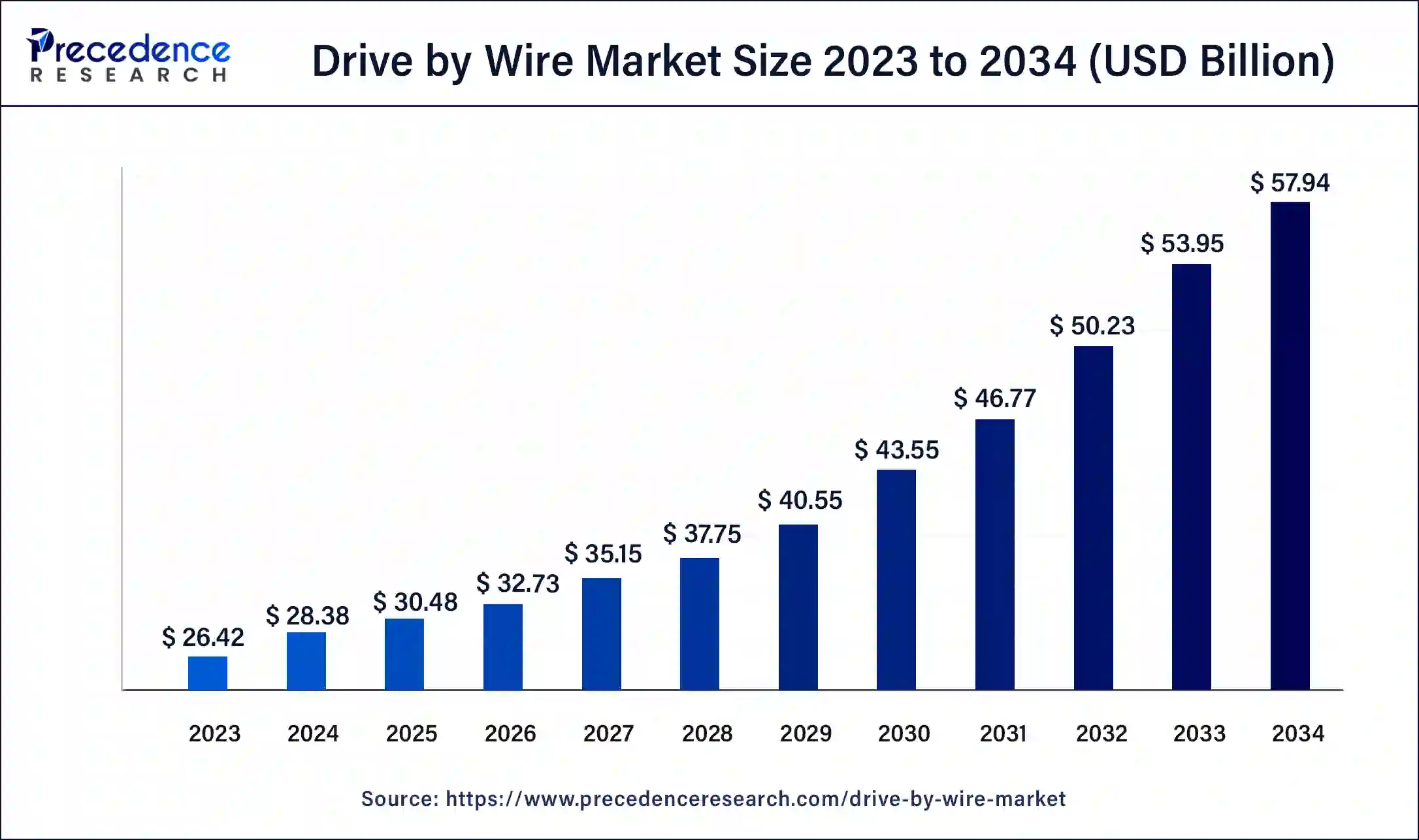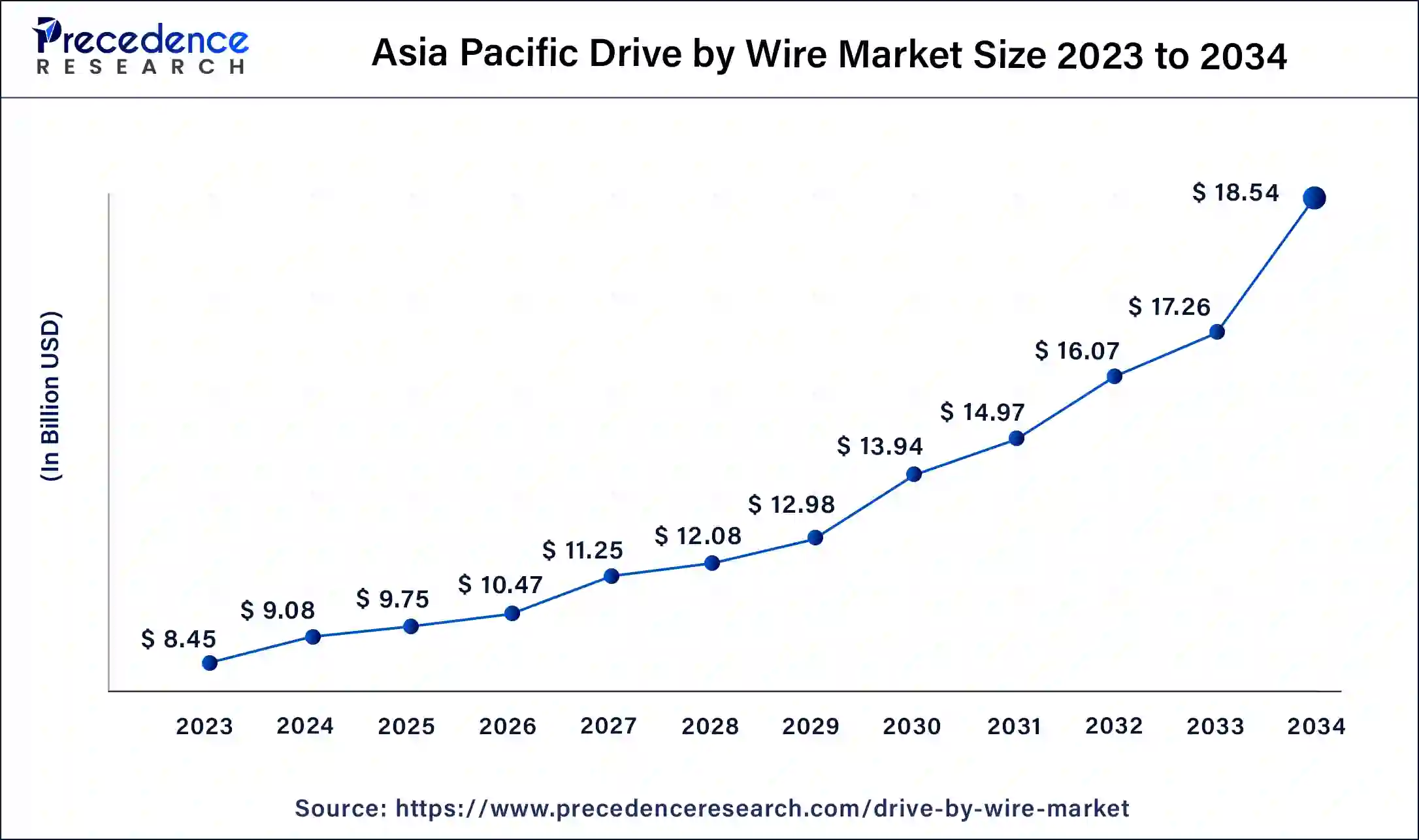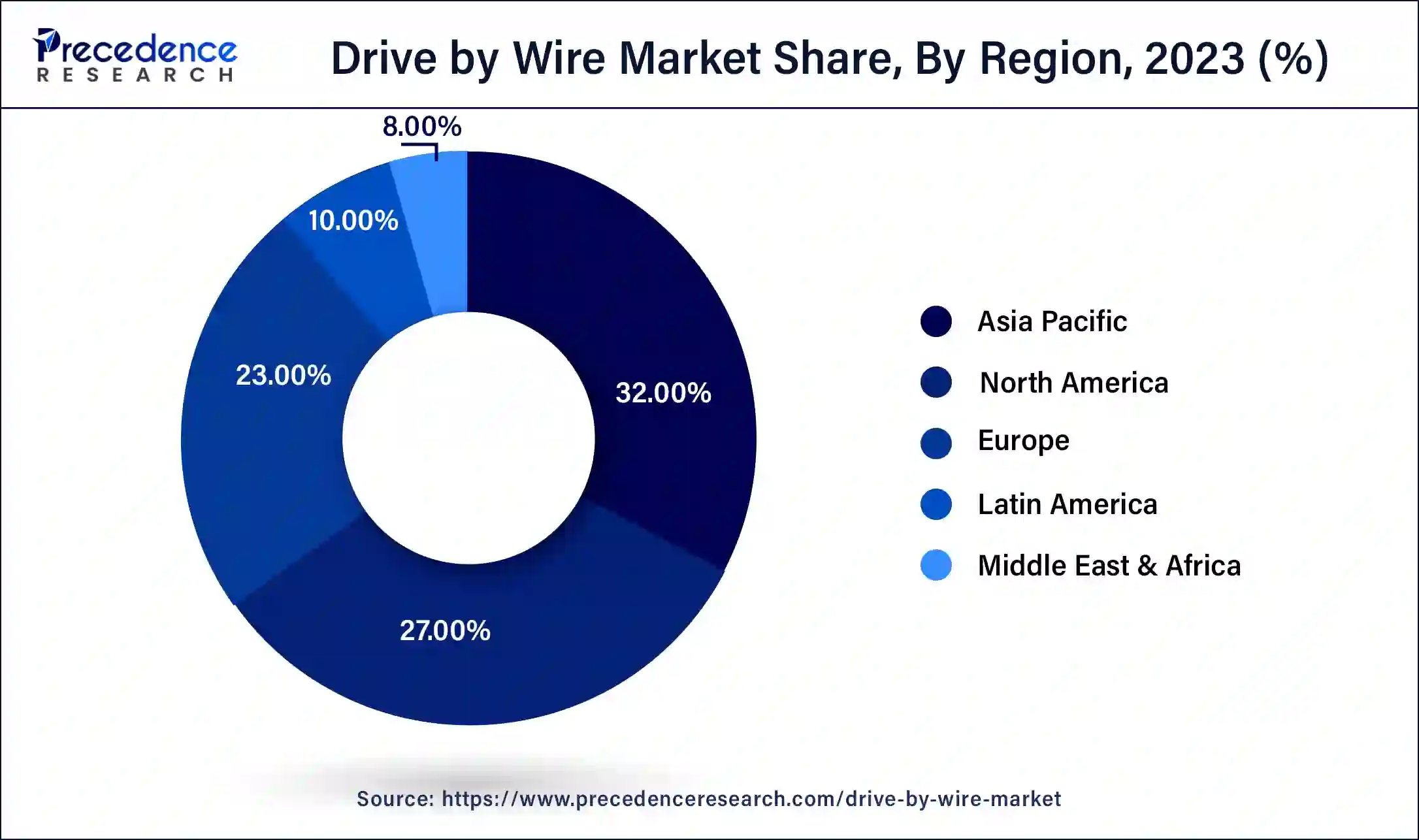February 2024
The global drive by wire market size was USD 26.42 billion in 2023, calculated at USD 28.38 billion in 2024 and is projected to surpass around USD 57.94 billion by 2034, expanding at a CAGR of 7.4% from 2024 to 2034.
The global drive by wire market size accounted for USD 28.38 billion in 2024 and is expected to be worth around USD 57.94 billion by 2034, at a CAGR of 7.4% from 2024 to 2034.

The Asia Pacific drive by wire market size was estimated at USD 8.45 billion in 2023 and is predicted to be worth around USD 18.54 billion by 2034, at a CAGR of 7.6% from 2024 to 2034.

Asia Pacific dominates the drive by wire market and is observed to sustain the position in the upcoming years. Consumers in Asia Pacific exhibit a strong inclination toward vehicles equipped with advanced features and technologies, such upcoming technological innovations are observed to supplement the market in the forecast period. Drive-by-wire systems, known for their enhanced safety, control, and automation features, align with the preferences of tech-savvy consumers in the region. Asia Pacific has witnessed a surge in the electric vehicle (EV) market. Drive-by-wire systems play a crucial role in electric vehicles, offering precise control and contributing to the overall electrification of vehicles. The region's focus on sustainable transportation solutions further propels the adoption of drive-by-wire.

Globally numerous environmental guidelines such as the Paris Agreement 2015 and the Kyoto Protocol 1998 were executed in order to reduce vehicle emissions and achieve the greenhouse gas emission norms. Over the past few years, researchers and manufacturers have been incorporating electronics and computers into the modern automobiles in order to facilitate the drivers to get accustomed to the technology. The drive-by-wire arrangement has the ability to increase safety, functionality, and comfort through the drive. Sensors and computers that are employed in these systems evaluate commands and send instructions to vehicles on precisely what to do. Such systems have an environmental approach, too, since the expertise could advance fuel economy and lessen engine emanation. The automobiles with drive-by-wire technology rely largely on electronics to regulate a wide variety of vehicle actions, including braking and acceleration. The drive-by-wire expertise is regarded as an environmental-friendly option. With better fuel range to lap up, the automobile owners can contribute to reduction in carbon emissions, which is certainly better for helping protect the environment that is sure to display a positive effect on the progress of market in the estimate period.
| Report Highlights | Details |
| Growth Rate from 2024 to 2034 | CAGR of 7.4% |
| Market Size in 2023 | USD 26.42 Billion |
| Market Size in 2024 | USD 28.38 Billion |
| Market Size by 2034 | USD 57.94 Billion |
| Largest Market | Asia Pacific |
| Base Year | 2023 |
| Forecast Period | 2024 to 2034 |
| Segments Covered | Components, Solution |
| Regional Scope | North America, Europe, Asia Pacific, Latin America, Middle East & Africa (MEA) |
Emergence of in-vehicle digitalization
In-vehicle digitalization is anticipated to rise as people spend additional time in their private vehicles. Popular linked features include Wi-Fi hotspot, digital keys, and navigation. Between these, digital keys will exhibit a high requirement in the approaching years owing to its low-cost execution. Voice recognition, virtual assistant, gesture control, and personalization will also experience augmented demand on rising concerns over surface contamination. Digitalization in automobiles will receive a boost from COVID-19 pandemic with people accepting a digital lifestyle that endorses hygiene, social distancing, efficiency, and tracking. Features and services permitting these lifestyle changes will exhibit growing popularity amongst car-buyers.
Cost of Implementation and Maintenance
Costs may vary depending on how difficult it is to incorporate drive-by-wire technology into new or old car architectures. It is necessary to consider safety features, communication protocols, and compatibility with other electronic systems. The kind of vehicle and the planned use can affect implementation costs.
More complex drive-by-wire solutions may be needed for high-performance automobiles or sophisticated autonomous systems, which would raise prices. Costs increase when safety and legal requirements are met. To guarantee that drive-by-wire systems achieve the necessary safety levels, they must adhere to local and industry safety requirements. Software updates, sensor calibration, and possible hardware repairs are all included in the cost of ongoing maintenance. Regular maintenance is essential for drive-by-wire systems to continue operating safely and effectively.
Innovation in Electric and Hybrid Vehicles
Steer-by-wire systems are frequently found in electric and hybrid vehicles, which do away with the requirement for a physical connection between the steering wheel and the wheels. This allows for incorporating advanced driving assistance systems (ADAS) and building cars with greater freedom. Throttle-by-wire systems use electronic sensors and actuators instead of the traditional mechanical linkage between the engine and the accelerator pedal. Drive-by-wire systems are an essential component in the creation and application of autonomous driving technology. Advanced driver-aid features like automated parking, adaptive cruise control, and lane-keeping assistance can be seamlessly integrated with these systems.
Vehicle electronic control unit segment holds the largest share in the drive-by-wire market. In the drive-by-wire market, the electronic control units overseeing and regulating the many operations of a drive-by-wire system are referred to as vehicle electronic control units or ECUs. These ECUs are in charge of processing sensor data, making decisions based on that information, and instructing actuators to perform vital operations for the vehicle. Controls the engine's air intake by managing the electronic throttle control system, which gets data from the accelerator pedal sensor and sends signals to the throttle actuator. Regulates the electronic braking system by deciphering the information from the brake pedal sensors and figuring out how much brake force should be put on each wheel.
Oversees the electronic power steering system, interprets steering angle sensor data, and directs the steering actuator to provide steering assistance or control. Determines the ideal shift locations and gear ratios by gathering data from multiple sensors and controlling the electronic transmission system. Controls electronic suspension systems to improve handling and ride comfort by modifying damping rates and other settings in response to sensor inputs. Combines and synchronizes the control of several drive-by-wire systems to provide safe and efficient operation. The vehicle's various ECUs, such as those in charge of engine control, safety systems, and advanced driver assistance systems (ADAS), frequently require communication and coordination with the vehicle's ECU.
Brake-by-wire segment holds the largest share of the drive-by-wire market. The electronic control of braking systems is the specific focus of brake-by-wire. The brake system in conventional cars is usually controlled by a hydraulic system that applies force to the brakes using a brake pedal. Brake-by-wire systems do not require a direct mechanical connection between the brake pedal and the braking components since they use electronic sensors and actuators to manage the braking operations. The central control unit calculates the proper braking force by analyzing data from multiple sensors. These sensors monitor several variables, including wheel speed, vehicle speed, brake pedal position, and other pertinent information.
The amount of force applied to each wheel during braking is managed by electronic actuators. Advanced communication networks are frequently used in brake-by-wire systems to enable quick and accurate data transfer between various components. Brake-by-wire systems frequently include redundant parts and systems to improve safety and dependability because of how vital braking is. Advanced control systems can improve vehicle safety by enabling electronic stability control and enhancing braking performance. Brake-by-wire can enhance total fuel efficiency by connecting with other vehicle control systems. Brake-by-wire systems eliminate the requirement for a direct mechanical connection between the brake pedal and the braking components, giving designers of vehicles greater design freedom.
Major Market Segments Covered
By Component
By Solution
By Geography
For inquiries regarding discounts, bulk purchases, or customization requests, please contact us at sales@precedenceresearch.com
No cookie-cutter, only authentic analysis – take the 1st step to become a Precedence Research client
February 2024
January 2025
January 2025
August 2023